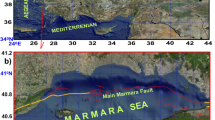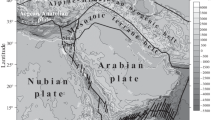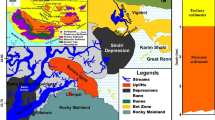Abstract
Western Anatolia has been formed by the motions of the African plate, Arabian plate and Hellenic Subduction zone. The Hellenic Subduction zone, which has high seismicity, is the main tectonic feature of the eastern Mediterranean Sea related to the subduction of the African Plate beneath the Aegean Sea Plate. The Hellenic Subduction zone has a complex lithospheric structure and shows complex differences in the Aegean Sea in terms of continental crust thickness and mantle velocity. In the study area, the directions of Global Positioning System (GPS) velocity vectors which are towards SE change towards S from North of Western Anatolia to Hellenic Subduction zone. It is thought that the factor which controls this mechanism is the shear force or subduction zone located in Aegean Sea. Western Anatolia region, which is located in Western Anatolia Extensional province, includes several morphologically significant N–S trending active normal faults. Besides, the NE–SW and NW–SE trending faults, which their kinematic features change from north to south, are very effective on the tectonic regime of the region. Additionally, for determining the boundaries of these tectonic elements, the Complete Spherical Bouguer (CSB) gravity anomaly of study area was calculated by using World Gravity Map (WGM2012) model. Moreover, in historical and instrumental studies, the high seismicity of the study area is remarkable. It is thought that this case is also related with the mechanism which oriented the GPS velocity vectors to southward. Consequently, the dominant kinematic structure of the region was classified by combining the GPS velocity vectors computed for Izmir and its surroundings bounded by Western Anatolia, Aegean Sea and Eastern Mediterranean and the CSB gravity anomaly. Finally, the results were interpreted together with focal depth distributions of earthquakes and Bouguer gravity data.







Similar content being viewed by others
References
Ahadov B, Jin S (2017) Present-day kinematics in the Eastern Mediterranean and Caucasus from dense GPS observations. Phys Earth Planet Int 268:54–64
Ambraseys N, Jackson JA (1990) Seismicity and associated strain of central Greece between 1890 and 1988. Geophys J Int 101(3):663–708
Armijo R, Meyer B, King G, Rigo A, Papanastassiou D (1996) Quaternary evolution of the Gulf of Corinth rift and its implications for the Late Cenozoic evolution of the Aegean. Geophys JR Astron 126:11–53
Bohnhoff M, Harjes HP, Meier T (2005) Deformation and stress regimes in the Hellenic subduction zone from focal mechanisms. J Seismo 9(3):341–366
Bonvalot S, Balmino G, Briais A, Kuhn M, Peyrefitte A, Vales N, Biancale R, Gabalda G, Reinquin F, Sarrailh M (2012) World gravity map. Commission for the Geological Map of the World. Eds. BGI-CGMW-CNES-IRD, Paris
Bozkurt E, Sözbilir H (2004) Geology of the Gediz Graben: newfield evidence and its tectonic significance. Geol Mag 141:63–79
Çırmık A, Pamukçu O (2017) Clarifying the interplate main tectonic elements of Western Anatolia, Turkey by using GNSS velocities and Bouguer gravity anomalies. J Asian Earth Sci 148:294–304
Çırmık A, Pamukçu O, Gönenç T, Kahveci M, Şalk M, Herring T (2017) Examination of the kinematic structures in Izmir (Western Anatolia) with repeated GPS observations (2009, 2010 and 2011). J African Earth Sci 126:1–12
DeMets C, Gordon RG, Argus DF, Stein S (1990) Current plate motions. Geophys J Int 101(2):425–478
Dewey JF (1988) Extensional collapse of orogens. Tectonics 7(6):1123–1139
Dewey JF, Şengör AMC (1979) Aegean and surrounding regions: complex multi-plate and continuum tectonics in a convergent zone. Geol Soc Am Bull 90(1):89–92
Dewey JF, Hempton MR, Kidd WSF, Şaroglu F, Şengör AMC (1986) Shortening of continental lithosphere: the neotectonics of eastern Anatolia-a young collision zone. In: Coward MP, Ries AC (eds) Collisional tectonics, vol 19. Geological Society of London, London, pp 3–36
Dogru F, Pamukçu O, Ozsoz I (2017) Application of tilt angle method to the Bouguer gravity data of Western Anatolia. Bull Miner Res Explor 155:45–55
Dolmaz MN, Hisarlı ZM, Ustaomer T, Orbay N (2005) Curie point depths based on spectrum analysis of aeromagnetic data, West Anatolian extensional province, Turkey. Pure Appl Geophys 162:571–590
Floyd M, Herring TA (2018) e-mail communications with Massachusetts Institute of Technology (MIT), Department of Earth Atmospheric and Planetary Sciences (EAPS)
Floyd MA, Billiris H, Paradissis D, Veis G, Avallone A, Briole P, McClusky S, Nocquet JM, Palamartchouk K, Parsons B, England PC (2010) A new velocity field for Greece: implications for the kinematics and dynamics of the Aegean. J Geophys Res 115:B10403
Förste C, Bruinsma SL, Abrikosov O, Lemoine JM, Marty JC, Flechtner F, Balmino G, Barthelmes F, Biancale R (2014) EIGEN-6C4 The latest combined global gravity field model including GOCE data up to degree and order 2190 of GFZ Potsdam and GRGS Toulouse. GFZ Data Serv 12:15. https://doi.org/10.5880/ICGEM.2015.1
Gessner K, Gallardo LA, Markwitz V, Ring U, Thomson SN (2013) What caused the denudation of the Menderes Massif: review of crustal evolution, lithosphere structure, and dynamic topography in southwest Turkey. Gondwana Res 24(1):243–274
Gilardoni M, Reguzzoni M, Sampietro D (2016) GECO: a global gravity model by locally combining GOCE data and EGM2008. Stud Geophys Geod 60:228–247
Goldsworthy M, Jackson J, Haines J (2002) The continuity of active fault systems in Greece. Geophys J Int 148(3):596–618
Goudarzi MA, Cocard M, Santerre R (2014) EPC: Matlab software to estimate Euler pole parameters. GPS Solut 18:153–162
Herring TA, King RW, Floyd MA, McClusky SC (2015) Introduction to GAMIT/GLOBK, Release 10.6. Massachusetts Institute of Technology, Cambridge
Hollenstein C, Müller MD, Geiger A, Kahle HG (2008) Crustal motion and deformation in Greece from a decade of GPS measurements, 1993–2003. Tectonophysics 449(1):17–40
https://www.afad.gov.tr/. Republic of Turkey Prime Ministry Disaster and Emergency Management Authority (AFAD)
Jackson J, McKenzie DP (1988) The relationship between plate motion and seismic moment tensors, and the rates of active deformation in the Mediterranean and Middle-East. Geophys J R Astron Soc 93:45–73
Kahle HG, Cocard M, Peter Y, Geiger A, Reilinger R, Barka A, Veis G (2000) GPS derived strain field within the boundary zone of the Eurasian, African, and Arabian plates. J Geophys Res 105(B10):23353–23370
Kahveci M, Pamukcu O, Cirmik AY, Gonenc T (2013) Using GPS data together with geophysical data: a case study from a seismically active region, Izmir. In: 6th international conference on recent advances in space technologies (RAST). IEEE, pp 231–236
Le Pichon X (1982) Land-locked oceanic basins and continental collision: eastern Mediterranean as a case example. In: Hsü K (ed) Mountain building processes. Academic, New York, pp 201–211
Le Pichon X, Angelier J (1979) The Hellenic arc and trench system: a key to the evolution of eastern Mediterranean area. Tectonophysics 60:1–42
Makris J (1978) The crust and upper mantle of the Aegean region from deep seismic soundings. Tectonophysics 46:269–284
Mart Y, Ryan WBF (2003) The tectonics of Cyprus Arc: a model of complex continental collision. Eur Geophys Soc Geophys Res Abstracts 5:02282
McClusky S et al (2000) Global Positioning System constraints on plate kinematics and dynamics in the eastern Mediterranean and Caucasus. J Geophys Res 105(B3):5695–5719
McKenzie DP (1972) Active tectonics of the Mediterranean region. Geophys J R Astron Soc 55:217–254
McKenzie DP (1978) Active tectonics of the Alpine-Himalayan belt: the Aegean sea and surrounding regions (tectonic of Aegean region). Geophys J R Astron Soc 55:217–254
Mercier JL, Sorel D, Vergely P (1989) Extensional tectonic regimes in the Aegean basins during the Cenozoic. Basin Res 2:49–71
NOAA, N (2006). 2-minute Gridded Global Relief Data (ETOPO2) v2
Nyst M, Thatcher W (2004) New constraints on the active tectonic deformation of the Aegean. J Geophys Res 109:B11406
Över S, Özden S, Kamacı Z, Yılmaz H, Ünlügenç UC, Pınar A (2016) Upper crust response to geodynamic processes beneath Isparta Angle, SW Turkey: revealed by CMT solutions of earthquakes. Tectonophysics 687:94–104
Pamukçu O (2016) Geodynamic assessment of Eastern Mediterranean region: a joint gravity and seismic b value approach. Arab J Geosci 9(5):1–13
Pamukçu O, Gönenç T, Çırmık YA, Kahveci M (2015) Investigation of the Sıgacık Bay’s displacement characteristic by using GPS and gravity data in Western Anatolia. J Asian Earth Sci 99:72–84
Pavlis NK, Holmes SA, Kenyon SC, Factor JK (2008) An earth gravitational model to degree 2160: EGM2008. EGU Gen Assem 10:13–18
Reilinger R et al (2006) GPS constraints on continental deformation in the Africa, Arabia, Eurasia continental collision zone and implications for the dynamics of plate interactions. J Geophys Res 111:B05411
Reilinger R, McClusky S, Paradissis D, Ergintav S, Vernant P (2010) Geodetic constraints on the tectonic evolution of the Aegean region and strain accumulation along the Hellenic subduction zone. Tectonophysics 488:22–30
Seyitoğlu G, Scott BC (1991) Late Cenozoic crustal extension and basin formation in west Turkey. Geol Mag 128:155–216
Smith WHF, Sandwell DT (1997) Global seafloor topography from satellite altimetry and ship depth soundings. Science 277:1957–1962
Sorel D, Mercier JL, Keraudren B, Cushing M (1988) Le role de la traction de la Lithosphere Subducte Dans L’evolution Geodynamique Plio-Pleistocene De l’Arc Egeen: Mouvement Verticaux Alternes Et Variations Du Regime Tectonique. C R Geosci 307:1981–1986
Stein S, Wysession M (2005) An introduction to seismology, earthquakes, and earth structure. Blackwell Publishing, Oxford, pp 290–296
Taymaz T, Jackson J, Westaway R (1990) Earthquake mechanisms in the Hellenic Trench near Crete. Geophys J Int 102(3):695–731
Tirel C, Gueydan F, Tiberi C, Brun JP (2004) Aegean crustal thickness inferred from gravity inversion, Geodynamical implications. Earth Planet Sci Lett 228(3–4):267–280
Wessel P, Smith WHF (1998) New, improved version of the generic mapping tools released. Am Geosci Union 79:579
Yılmaz Y, Genç C, Gürer F, Bozcu M, Yılmaz K, Karacık Z, Altunkaynak Ş, Elmas A (2000) When did the western Anatolian grabens begin to develop? In: Bozkurt E, Winchester JA, Piper JDA (eds) Tectonics and magmatism in Turkey and surrounding area, vol 173. Geological Society of London, London, pp 353–384
Author information
Authors and Affiliations
Corresponding author
Rights and permissions
About this article
Cite this article
Kahveci, M., Çırmık, A., Doğru, F. et al. Subdividing the tectonic elements of Aegean and Eastern Mediterranean with gravity and GPS data. Acta Geophys. 67, 491–500 (2019). https://doi.org/10.1007/s11600-019-00270-w
Received:
Accepted:
Published:
Issue Date:
DOI: https://doi.org/10.1007/s11600-019-00270-w




